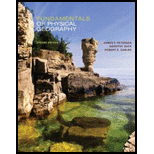
(a)
The height of the LCL if the air parcel has a temperature of
(a)
Answer to Problem 2PA
The height of the Lifting Condensation Level (LCL) is
Explanation of Solution
The height of an air parcel at which the condensation begins is termed as Lifting Condensation Level (LCL). The formula to determine the LCL is as follows:
Substituting the values of Celsius temperature as
To identify the temperature of air parcel at
Given info:
The temperature of the air parcel =
The height of the Lifting Condensation Level (LCL)
To identify the distance between the starting point and the point of condensation, subtract the point of condensation with the starting point.
Substituting the values
Now, divide
Now, subtract the starting temperature (
Therefore, the temperature at the point of condensation is
Now, to determine the distance between the highest point (
Now, divide
Now, to identify the temperature of air parcel at 4000 meters,
Substituting the value
Therefore, the temperature of air parcel that is at
(b)
The calculation of temperature and dew point temperature of an air parcel that has descended to 2,000 meters, which was previously at 6,000 meters having a temperature of –5°C and a dew point of –10°C.
(b)
Answer to Problem 2PA
The temperature of the descending air parcel is
Explanation of Solution
Given info:
The temperature of air parcel at 2000meters = ?
The general rule is that the temperature increases by
| Height of air parcel (in meters) | Temperature (celsius) | Dew point temperature (celsius) |
Therefore, the temperature of the descending air parcel is
Want to see more full solutions like this?
Chapter 5 Solutions
Fundamentals of Physical Geography
- 7. _ The climate-change scientist Mike Hulme has argued that people who tend to see nature as tolerant, and who believe that global climate properties would likely respond very favourably to certain planetary geo-engineering solutions, tend to be: a. egalitarians. b. hierarchists. c. individualists.arrow_forwardCronon’s Research on Wilderness – Consider Cronon’s study of wilderness, as discussed by Kanazawa (2023). In what ways, if any, would it have been appropriate for Cronon to have used quantitative methods in his study of the concept of wilderness, and to what end? Why were qualitative methods particularly appropriate for the study, given the nature of his research topic? 150-200 words response to the questionarrow_forwardConsider Cronon’s study of wilderness, as discussed by Kanazawa (2023). In what ways, if any, would it have been appropriate for Cronon to have used quantitative methods in his study of the concept of wilderness, and to what end? Why were qualitative methods particularly appropriate for the study, given the nature of his research topic?arrow_forward
- Why might drought actually cause fire risk to reduce in a desert area?arrow_forwardPart 1: A completely saturated sample of sandstone has a bulk density of 2.61 g/cm³, an effective porosity of 10 percent, and a total porosity of 12 percent. Determine the density of the solid phase (i.e., the density of the mineral). Part 2: One cubic meter of quartz sand has a dry mass of 2,320 kg. a) Calculate the porosity of the sand. b) Calculate the mass (in kg) of the sand for the following degrees of saturation: 25 percent, 75 percent, 100 percent. Part 3: A sample of quartz sand has a dry mass of 753.7 kg and a volume of 0.36 m³. a) Calculate the porosity of the sand. b) Calculate the mass (in kg) of the sand assuming a degree of saturation equal to 62 percent.arrow_forwardWhat is an oxbow lake and how is it formed?arrow_forward
- For the past 3 million years the earth has experienced glacial-interglacial cycles at regular intervals that coincide with the Milankovitch Cycles. Please briefly describe the three Milankovitch Cycles and their timescales. What is the leading theory for why the timing of glacial-interglacial cycles is connected to these Milankovitch Cycles?arrow_forwardWhy do waterfalls move backwards over time? In your explanation, please use the term “nickpoint”?arrow_forwardThe picture below is of the Kaskawulsh Glacier in Yukon, Canada. What is the name of the type of feature that the red arrows are pointing to in the middle of the glacier and how are these features formed? In your answer please also define the term lateral moraine and how lateral moraines relate to the feature with the red arrows?arrow_forward
- it was stated that one major effect of rivers is to flatten out the continents. How do rivers flatten continents?arrow_forwardThe figure below shows the average change in glacier mass per unit area for various mountainous regions around the world. Why are the globe’s mountain glaciers shrinking? Does glacial melt increase or decrease the amount of water stored on the continents? What are the factors in the continental water budget equation that must change in order to restore equilibrium when glaciers melt ? What is the effect on global sea level?arrow_forwardWhat is continental precipitation recycling ?Using the concept of precipitation, please explain why changes in landcover in one place can feed back to impact the climate not only in the area where the landcover change occurred but also in other regions?arrow_forward
 Applications and Investigations in Earth Science ...Earth ScienceISBN:9780134746241Author:Edward J. Tarbuck, Frederick K. Lutgens, Dennis G. TasaPublisher:PEARSON
Applications and Investigations in Earth Science ...Earth ScienceISBN:9780134746241Author:Edward J. Tarbuck, Frederick K. Lutgens, Dennis G. TasaPublisher:PEARSON Exercises for Weather & Climate (9th Edition)Earth ScienceISBN:9780134041360Author:Greg CarbonePublisher:PEARSON
Exercises for Weather & Climate (9th Edition)Earth ScienceISBN:9780134041360Author:Greg CarbonePublisher:PEARSON Environmental ScienceEarth ScienceISBN:9781260153125Author:William P Cunningham Prof., Mary Ann Cunningham ProfessorPublisher:McGraw-Hill Education
Environmental ScienceEarth ScienceISBN:9781260153125Author:William P Cunningham Prof., Mary Ann Cunningham ProfessorPublisher:McGraw-Hill Education Earth Science (15th Edition)Earth ScienceISBN:9780134543536Author:Edward J. Tarbuck, Frederick K. Lutgens, Dennis G. TasaPublisher:PEARSON
Earth Science (15th Edition)Earth ScienceISBN:9780134543536Author:Edward J. Tarbuck, Frederick K. Lutgens, Dennis G. TasaPublisher:PEARSON Environmental Science (MindTap Course List)Earth ScienceISBN:9781337569613Author:G. Tyler Miller, Scott SpoolmanPublisher:Cengage Learning
Environmental Science (MindTap Course List)Earth ScienceISBN:9781337569613Author:G. Tyler Miller, Scott SpoolmanPublisher:Cengage Learning Physical GeologyEarth ScienceISBN:9781259916823Author:Plummer, Charles C., CARLSON, Diane H., Hammersley, LisaPublisher:Mcgraw-hill Education,
Physical GeologyEarth ScienceISBN:9781259916823Author:Plummer, Charles C., CARLSON, Diane H., Hammersley, LisaPublisher:Mcgraw-hill Education,





